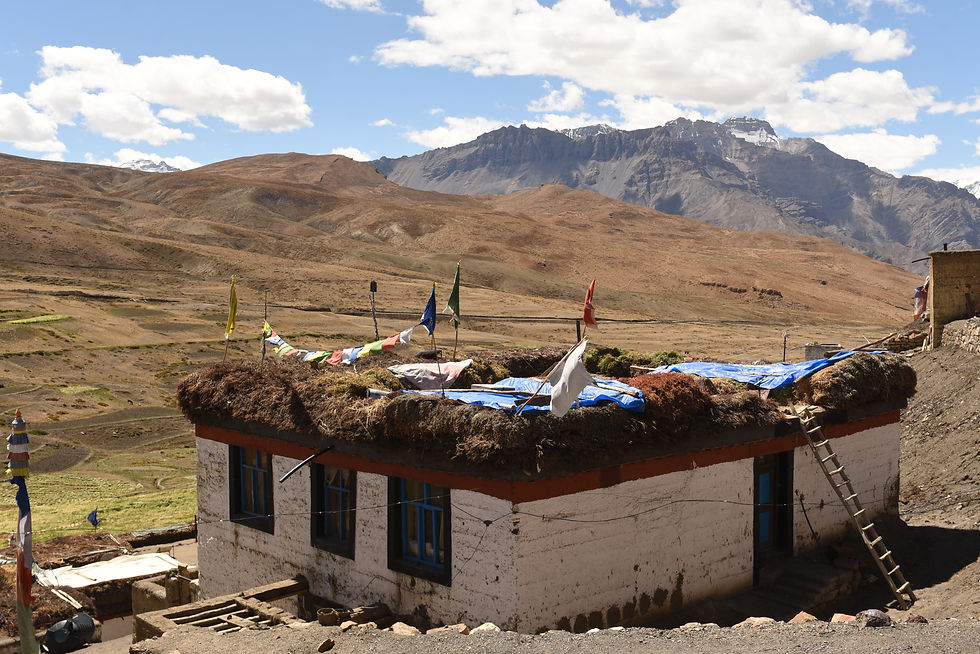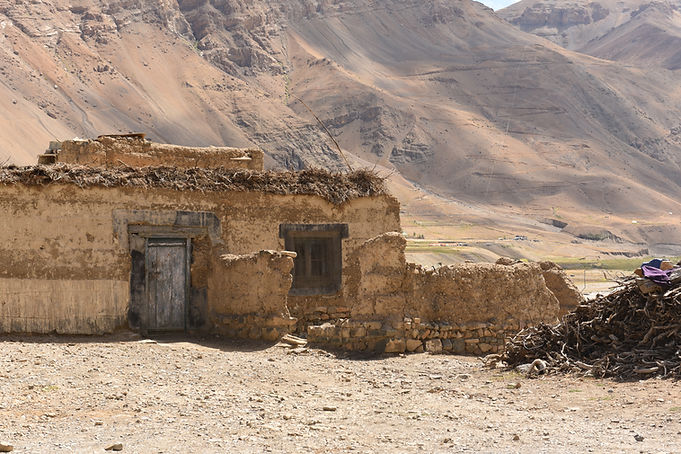
Traditional, Modular
& Climate Resilient
Earth Homes of Spiti
A photo-story showcasing the rammed earth architectures of Spiti that withstand extreme climatic conditions
For those who must have seen the breathtaking landscapes of Spiti must have landed their eyes on the beautiful mud homes that surround the valley.
Buildings of this construction type can be found in the Spiti river valley of the districts Lahaul and Spiti. This construction type has been in practice for more than 200 years. The earliest good example is the 1000 year — old Tabo Gompa/Monastery.
Produced by:
The Impact Society
In Association with:
Spiti Ecosphere
Mentored by:
Rakesh Rao & Ishita Khanna
Production Team:
Pinkie Makhijani, Tenzin Tsering
Scripting by:
Anchal Goil
Contributors:
Payal Kumar, Amit, Apoorve, Madhura, Netra
Pooja, Zarna, Sae, Reshma, Priyanshi Thakkar

Picture Credits: Priyanshi Thakkar
From then to now...
Close your eyes and allow yourself to be transported back in time, to the sandy slopes and frigid cold of the Spiti Valley. Here, communities live in close-knit settlements, dependent on each other, and the forces of nature, for their collective survival.
In this age, locals would traverse the barren plains on foot, under the scorching heat of the naked sun, towards the better populated and connected cities and townships of Shimla, Kullu, Manali or Rampur. They would return weeks later, accompanied by donkeys and mules laden with rations for the whole village.
In these days, the modern comforts and amenities of toilets, bathrooms and more were as alien a concept as snow in the summer. Locals would bathe in the barren open lands, using soil as their soap, with the sun as their only companion.
While a lot has changed in the Valley since this time gone by, there is much that remains the same, and with good reason.
'Ancient Wisdom'

Just as every grain of this sandy terrain was once a mountain,
a cliff or a crag, worn down to powdery remnants by the
constant battering of wind, rain, and ground-shifting landslides,
the locals in the area carry out their lives with but one certainty:
"Winter is Coming"
The ancestors of the Spiti Valley had to learn to live and adapt to the very harsh conditions that the Valley is known for today. A resilient people, these locals made use of what little resources they had to live full and vibrant lives as a community, sharing resources and never taking more than they could give back.
This environmentally-conscious manner of existence was not a noble act to preserve the natural integrity of the valley, but rather a way of life that existed not in defiance of the natural world, but in celebration of it. Women would stitch and children would study pottery, while the males tended to farm activities.
One such piece of ancient knowledge that has stood the test of time, is the practice of constructing and inhabiting Spiti’s famous mud homes.

Picture Credits: Priyanshi Thakkar
The Art & Science of
Earth Homes
In those early days, the construction of these mud homes was a communal activity. Locals would join hands to help construct the structures from stones, boulders and soil, as well as traditional wood known as Chuppa, which was bartered against livestock for the construction of the homes.
This communal effort would be free of charge, with the participants breaking bread as a celebration of the completion of their collective undertaking.
While much has changed since then, and much of the communal spirit of collaboration and mutual aid has been lost to the winds of time, eroded with the mountain faces, Spiti’s characteristic mud home settlements still exist to this day.
Picture Credits: Pooja Naik & Priyanshi Thakkar






Location: Kwang
Altitude: Approx. 1189m above sea level
Upon our arrival to Kwang, a quaint village near Kaza in Spiti, we were graciously greeted by a local man named Tangpa, who took us around his ancestral home.
The house itself was an unassuming brown structure, not dissimilar to the others in the area. However, this modest home housed many secrets, and just as many tales of ancestral knowledge hidden within its walls.
The walls themselves were fortified against the harsh and unpredictable weather, naturally insulated by layers of soil, wood, twigs, hay and boulders which were turned into mud blocks. The roofs are similarly insulated with a multi-layered protective barrier of wood, soil, twigs and grass, that serve to keep the inside moist and warm, a pleasant departure from the arid, cold climate of the area.

Sonam Tenzin
"Back in those days people used to help each other make homes and live in harmony as a community, with no money involved whatsoever. Once the home was made, everyone used to come along for a feast, while today that spirit is lost"
Picture Credits: Pooja Naik
Built & Designed
to endure extreme weather
The entire region is an arid cold desert where timber is scarce and mud is the main locally available construction material. These buildings are therefore made of rammed earthen walls and timber is solely used for floors and roofs as well as for door and window frames. Natural stones are also scarce and are thus only used for foundations.
Precipitation in this region, usually only occurs in the form of snowfall with almost no to very little rainfall. This dryness of the local climate is reflected in the architecture of this construction typology which consists of thick mud walls with small openings in order to insulate the interior from the harsh outside climate.
Wooden windows form protective barriers against the cold, and the ceiling is adorned with a skylight that allows for natural light and heat to filter into the home. This skylight, Tangpa explained, is also useful to inhabitants as an indoor timekeeper. This is achieved by placing a stick on the floor under the direct rays of the sun, transforming the stick into a makeshift sundial.
Picture Credits: Pooja Naik




As we toured the house, we encountered various interesting architectural & structural adaptations that speaks volume of our indigenous & traditional knowledge systems.
Life in the winters can be extreme with temperatures dropping upto -30 degrees with harsh and swift snowy winds piercing through the skin. Living under these conditions is a challenge and usually involves months of planning.
Locals are always in an evolving transition between the outdoors and indoors, where each aspect of sustenance is planned - right from buffer zones in the house for fodder, livestock, utilities, common storage and living. Families would have to cohesively work in order to survive such climatic conditions coupled with shortage of resources.
A symbol of the resilience of people living in some of the harshest conditions imaginable on Earth, these mud homes utilized every available resource to its most optimal use.
Picture Credits: Priyanshi Thakkar, Pooja Naik & Payal Kumar






These homes are carefully and meticulously demarcated for a variety of different utilities.
There is a common room, known as a Yokhang, where families would sit together around the light and warmth of a fire. The ceiling is fitted with a pipe leading upwards to release the toxic fumes and smoke into the open air. The room would also double as a kitchen, bedroom and sitting space.
Another area hidden in the roof is used for storage, used to stock hay, wood and other materials. There were buffer zones dedicated to the housing of livestock during the 6-month long winter. These included herds of Yak, Horses, Cows and Zomo - a hybrid between the Yak and domestic cattle. There were ample provisions for storing fodder too.
These rooms would typically remain warm, due to the methane produced by their inhabitants, and served as buffer zones from the cold weather. The dung from these animals would be used for fire, serving to keep the inhabitants of the house warm.
Below the structure, pits stocked dry rations from the fields. These rooms were dry and cool and stacked with hidden mountains of barley and wheat only accessible through a small opening.
Food supplies made its way to mud fridges, built into an insulated 2-3 foot thick wall, covered with mud from outside and wood from inside, preserving important food products such as ghee, butter and meat.
Wherever you looked, the house demonstrated its unique connection with sustainability and ancestral knowledge.

Every house is also fitted with dry compost toilets - waterless toilets that serve as two-part solutions to both sustaining traditional agricultural practices, as well as conserving water in the parched region.
These Dry Toilets, also known as Compost Toilets, consist of two levels: a toilet on the top level, and a composting unit underneath. When the toilet is used, a bit of cow dung, which is mixed with ash collected by the local community over the winter months, is shovelled into the composting unit through a hole, to facilitate decomposition by microorganisms. This dirt mixture eliminates any foul smell. These toilets require no water, are free of foul smells, and are impressively hygienic.
Every October-end, the composting unit of every household is cleaned by the locals with the help of neighbours, friends, and relatives, and is decomposed until the coming of April. The naturally formed dry manure is then mixed with goat and yak dung and used in the fields before ploughing.
An Art lost in transition
With each passing year, these homes are losing its value and charm to new cemented structures, all that remains are remnants of its losing culture.
A cylindrical tank fitted with a wooden beater used to prepare tea and buttermilk lay against a wall. Crockery made from stone, known as a Doltok, and mugs made entirely from mud, known as a Ghadda, were produced from the tiny kitchen.
The ancient practice of pottery, which was once a flourishing discipline in the region, has been lost to time, leaving behind only these expertly crafted remnants of the artisans of the area.
Picture Credits: Priyanshi Thakkar




Check Out
The Film
This film is built upon the backbone of spreading scientific and cultural awareness via visual communication. As part of the expedition, our crew with the participants shot, edited, and scripted mini-stories of Impact in the Spiti Valley.
Check the preview here!
The Impact Society
We are a multi-disciplinary collective composed of writers, filmmakers, photographers,creators, artists, explorers, conservationists, scientists & more, that aims to drive social change & build collective awareness towards the dire issues of our times, throughexperiential learning & impact-creation initiatives.

